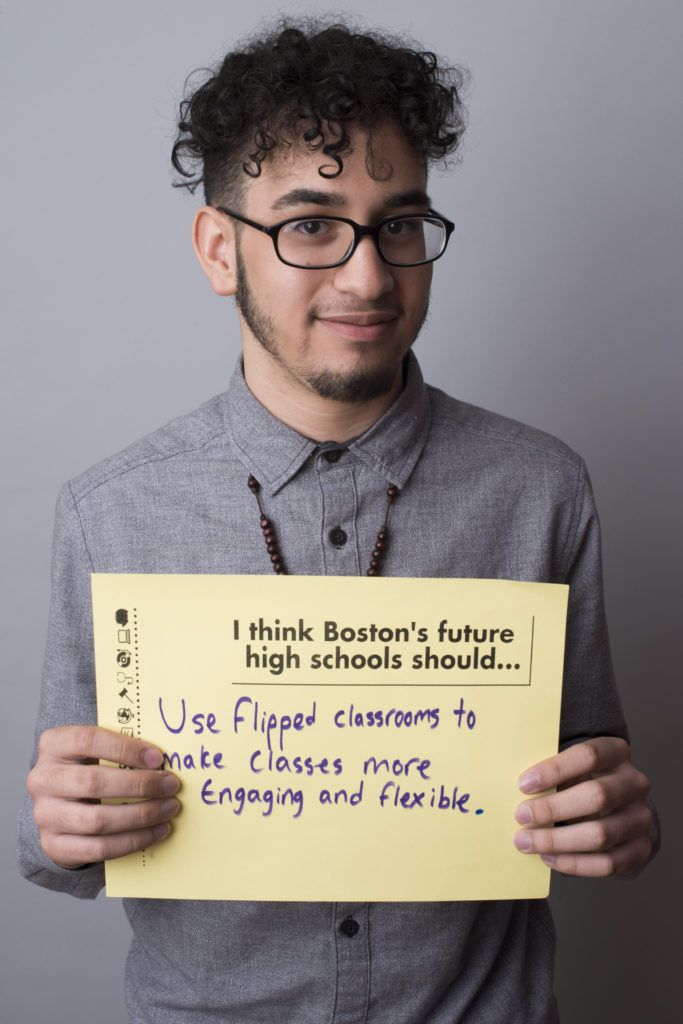
By Jhoangel Fernández Ramírez
What if when students woke up, they could not wait to go to school to learn and be creative? There are multiple possibilities for making schools more engaging, but one way that I think BPS high schools should be changed is with technology. A great way to add technology to schools is through flipped classrooms. A flipped classroom is the opposite of a traditional classroom, where the lectures are done at home instead, with a video lesson or podcast from the teacher, and the homework is done in school. If you need help you can ask the teacher or work together with other students.
Jhoangel: It’s like, I don’t know, it’s like a school evolution.
I spoke with Nick Gonzales, Digital Learning Specialist for the Boston Public Schools, about flipped classrooms. Here is an excerpt from the interview:
Jhoangel: My first question is, can flipped classrooms become the change that BPS needs?
Nick: Yes, it can be one of them, it can definitely be one of them. Flipped classrooms are a very good approach to teaching any course or any subject. However, although a flipped classroom is very useful, it doesn’t take the place of a teacher. You still need a teacher in a class. But it’s a great method, and a great approach to teaching content.
Jhoangel: What other programs [can be used in school]?
Nick: There’s a bunch of approaches you can take to using technology in the classroom. For example, there’s coding and programming. People tend to think that it’s just applicable to science and math, and those are two of the things you can use it with. But you can program different songs – you can use it with music. And you can program an animation that’s got something to do with Romeo and Juliet. Are you familiar with the game Assassin’s Creed? Well that’s a really great way to teach history because it shows the different worlds of different eras really well. And you can program that using Scratch and Java.
That’s just one other method. You can also use Google Classroom, you can do collaboration using Google Docs, you can make movies using iMovie and Premier and other applications. So there are a myriad of different ways you can use technology in the classroom. But Google Classroom is one of the main ones right now, and it’s really useful.
Jhoangel: I honestly want to see it in action.
Nick: Well, I use it in my courses. I’m still a teacher—I’m an adjunct professor at Bunker Hill Community College—and I use a flipped classroom approach sometimes in some of my online classes, where [my students will] watch something at home, then come in and discuss it, and it works really well. But I need to stress this as well: it doesn’t take the place of a teacher. You’re always going to need a teacher. You always need someone to push, even for adults that use flipped classes. I teach college kids, and unless they’re really, really motivated a lot of them won’t do it. So you still need that person.
Jhoangel: Can you see Margarita Muñiz Academy having flipped classrooms?
Nick: I can, but the administration needs to buy into it, and your principal really needs to buy into it, and she or he needs to understand its implications and understand them thoroughly, because without that—without the administration really understanding and buying in—it’s really hard to push this. It really is, because a lot of administrators don’t understand the thinking behind it, don’t understand the sophistication. A lot of them are stuck in the old: teacher in front of a classroom. It’s not like that anymore. So a lot of teachers know, but administrators, administrators are the hard ones….a lot of people need someone to sit down face-to-face and help them, and that’s what my team does. So if you want the teachers at Margarita Muñiz to learn how to do flipped classrooms, you tell them to contact the Digital Learning Team at the Boston Public Schools.
Jhoangel: That’s how I feel the way school is right now…we’re stuck in old traditions, and we need to move on. This is why I’m doing what I’m doing.
Nick: Yeah. Our schools are modeled on schools from what’s called the Industrial Era, during the Industrial Revolution, where it’s 8 to 5 every day. That’s how companies are set up, right? But you don’t need to have schools inside walls anymore, right? You can do your homework on the bus on your phone, and it’s like you can be in school twenty four hours a day. And the same thing is happening with jobs. But the current model of the school is changing, and it’s younger people starting to change it: people like you. You’re asking questions already. I’ve been asking this question for the last five years. And it’s going to change. It’s just the nature of education.
Jhoangel: It’s like, I don’t know, it’s like a school evolution.
You must be logged in to post a comment.